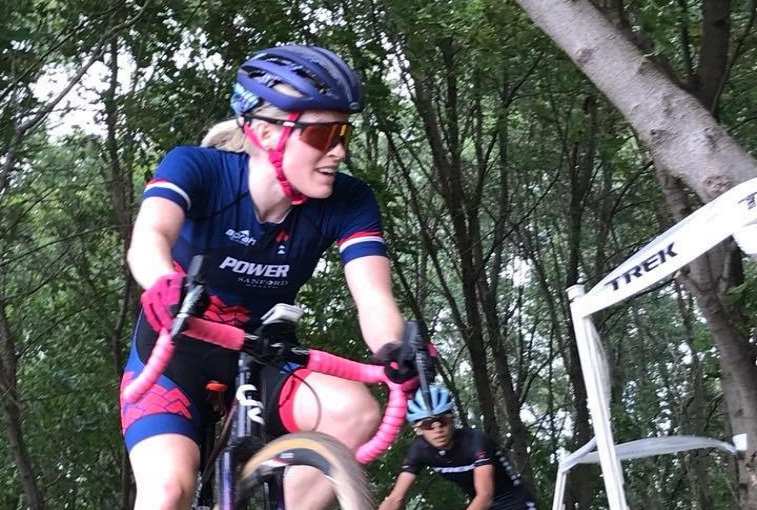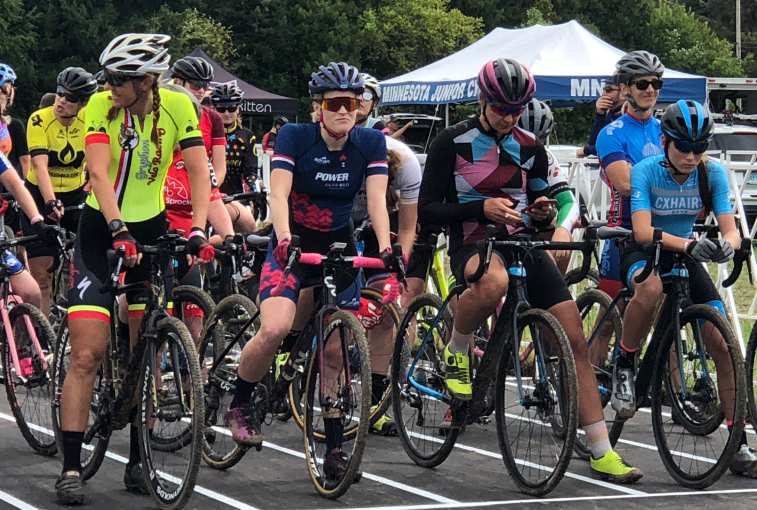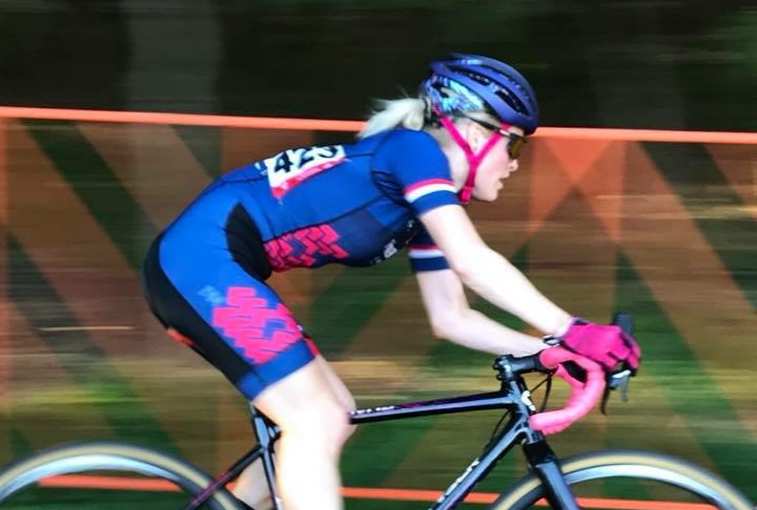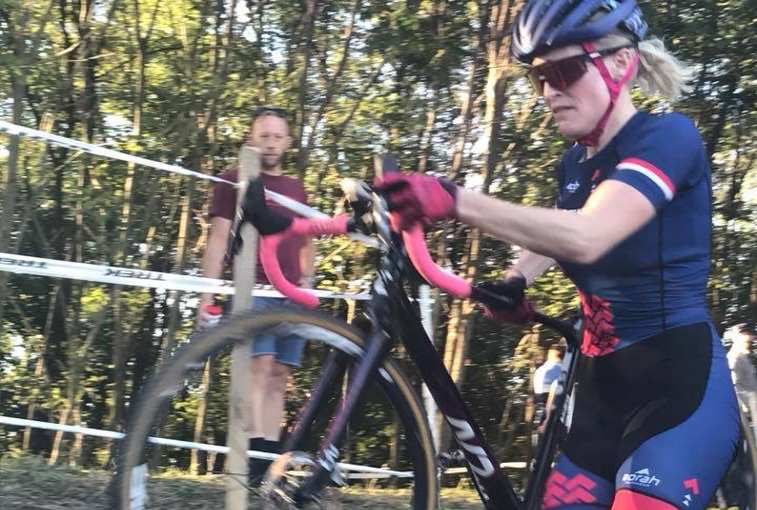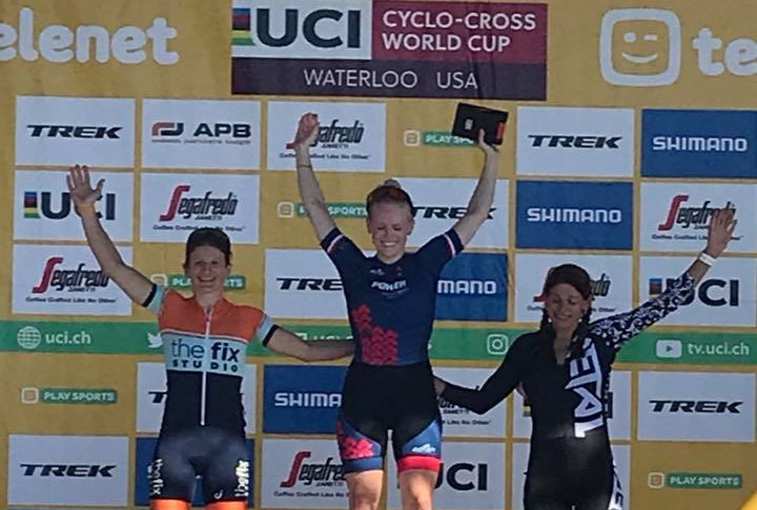WATERLOO, Wis. — Molly Clark-Oien stands there, her white blonde hair half shaved and half pulled up into a messy bun with bobby pins beneath her bike helmet. She tilts her shoulders in this sinewy and intimate way as she leans on the handlebars of her bike, one foot snapped into one pedal, and looks at the women around her.
They’re outside a gate, assembling in a semi-circle as they wait for the race official to call them up, one by one. When they hear their name, they push forward, flash a race number pinned to the side of their jersey, get a nod and then roll into whatever row is filling in next, eight riders wide, on a small piece of asphalt that marks the staging area.
At the sound of a whistle, the pavement will give way to a curving grass, sand and dirt racetrack about a mile long, full of tight corners, steep climbs and manmade structures that require riders to quickly dismount, pick up their bikes and run them up stairs or over obstacles before hopping back on and riding again.
This is cyclocross.
It’s a muddy mess of interval training meets endurance meets technical skills, with plenty of room for error on courses that change for every race. Riders are grouped by gender and skill level, with the race length measured in accordance. Beginners -– called category 5 racers -– ride loops for about 30 minutes.
Those at the top -– in category 1 -– ride for 45 minutes to an hour.
That’s where Clark-Oien is –- the first woman to hit that level for South Dakota, and the only current category 1 cyclocross racer in the state. She made the move in late 2017, after just three years of racing. It was significant enough to garner the attention of Sanford Power, the team she now represents.
“I didn’t know when I started riding how far I could take this,” says Clark-Oien, 31, who was born and raised in Fargo, North Dakota, and has a long history of track, cross-country and then steeplechase for Augustana University, where she studied psychology. “I knew I had an ability to be successful, but I didn’t know what that would look like. It was overwhelming and kind of wild to think of where I started.”
Where she started was a small local race at Sherman Park in Sioux Falls, South Dakota, which her husband and fellow bike racer Peter Oien encouraged her to enter.
She won.
“I was hooked after that,” she says.
‘Push past pain’
What it looks like now is Clark-Oien at the front of the starting line of this race at the Trek CX Cup and UCI Telenet Cyclocross World Cup in Waterloo, Wisconsin, staring ahead in her navy blue jersey with the Sanford Power logo on the front, pink cycling shoes and “fighter girl” scrawled across her handlebars.
The women wait while the race official explains the rules: They’ll time the first two laps of the leaders, then racers will know how many total they have to do. Everyone finishes on the same lap, which means if you get lapped -– and it happens –- you stop when the winners stop, riding out the end of whatever loop you’re on. Be courteous to other riders. Ride safely. Have fun.
Be fierce.
There are no guarantees in cyclocross, and when the whistle blows, it’s every rider for themselves as they go as hard as they can through the chute, knowing the course will narrow quickly. It’s better to start out in the front than try to maneuver your way around another rider as you round a corner or grind to the top of a flyover, wooden ramps that bring riders up and over so the course can wind beneath and back on itself, making efficient use of the park.
The straightaways are few and far between, with small opportunities to pass someone –- and knowing that to do it, you’ll have to choose a sketchier line because whoever is right in front of you gets first choice.
That means you need the patience to ride someone’s wheel, the technical skills to pass them on unfavorable terrain and the strategy and confidence to know when it’s time to go. And don’t forget the part where you’re doing this all really quickly, elbow to elbow with other riders, on a bike.
“I feel like I can go pretty deep in discomfort and push past pain, maybe better than other people, because I had run for so long,” Clark-Oien says.
Getting into cyclocross
After that first race in Sioux Falls, she began to take the sport more seriously –- taking indoor cycling classes at Spoke-n-Sport, the shop where Oien works and another sponsor for her racing. Cyclocross appealed to her because of her years of running.
“It replicated running in terms of the difficulty and pushing through pain,” Clark-Oien says. “But it’s different. Running gets progressively harder as the fatigue sets in. In cyclocross, it’s more peaks and valleys.”
It doesn’t look that way from the outside, as these women hammer their way around the course, spectators leaning against the tape and gates that mark it, shouting encouragement to the field as riders run up stairs or steep hills, carrying their bikes over their shoulders.
“The different terrain reminded me of cross-country on your bike,” Clark-Oien says. “And the barriers were exciting because I thought, ‘oh, I used to steeplechase,’ and this is kind of like that.”
It’s that kind of unbridled enthusiasm that makes Clark-Oien energizing to watch race and a joy to talk with afterward. She’s encouraging to other riders, and the only time she isn’t cheering for someone else’s race are the moments she’s warming up or cooling down for her own.
More women sponsored
This is an American dream at its best -– here’s a young woman who gave something a try at a park near her house, added in her experience, raw talent and relentless drive and was able to quickly climb her way to the top, interval by interval, course by course, through crashes and lessons learned.
Larry Martin, regional manager with USA Cycling, says making the jump to category 1 is a major accomplishment. Racers move up based on their finishing position and the quality of the field they’re racing against.
“It’s a tough crowd,” Martin says. “Molly travels quite a bit to get to the bigger races, and she does well.”
Clark-Oien fared well at Trek, finishing first in the single-speed category and sixth and 15th in two other races that weekend.
For Sanford Health, sponsoring nontraditional athletes -– like cyclocross –- makes sense, says Jeff Fylling, senior public affairs specialist for Sanford Health. “It’s important to have athletes from all different sports -– it helps us in our research and the work we do with the Sanford Sports Science Institute for injury prevention and training.”
Clark-Oien said the Sanford Health sponsorship came at the right time for her, as she transitioned to category 1.
“There are a lot more men than women who seem to acquire sponsorships,” she says. “It’s starting to turn the other direction, so this was a pretty cool thing.”
Growing sport
The sport has grown significantly –- with participation tripling in the past decade, says Martin of USA Cycling. “It’s at the point where we’ve reached saturation in some of the biggest races, like the Trek Cup. Most of the individual races were sold out because the fields were full,” Martin says.
That means crowded courses, and Clark-Oien credits her early years playing basketball and soccer with helping now, too.
“A big thing that’s helped me is spatial awareness of where others are,” she says. “Sometimes people who cause crashes are just unaware of where they are and where other people are.”
But she knows there’s more to it, too.
“And sometimes stuff just happens,” she says. “Everyone makes mistakes.”
That’s classic Clark-Oien: Talk about the expert skill required to race, and then immediately follow it with humility and understanding.
She says as she’s skyrocketed in the sport, people have asked her if she’s frustrated when she doesn’t place, or consoled her when she hasn’t done as well as she could have. But she doesn’t see it that way.
“There are a lot of strong women racers, and I don’t go out there all the time expecting to win. That would be unrealistic,” she says.
Instead, she sees every race as an opportunity, and she finds small successes every time.
“I love figuring out stuff that was tough or challenging for you before, or you felt uncomfortable,” she says. “It can be as minor as riding something that before you had to run up, or you didn’t have the confidence and strength to do it, and now you have it down.”
…
Posted In Healthy Living, Sanford Sports, Sports Medicine, Women's
